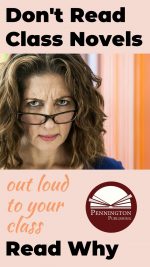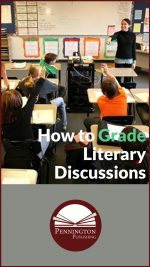Don’t Read Class Novels
Not read class novels? Better read the subtitle: Out loud to your class… In terms of teaching literature, I live in two worlds. I am an English-language arts teacher and a reading specialist. Although the two worlds would seem to be quite complementary, this is not always the case.
As an English-language arts teacher, I love teaching the nuances of the author’s craft. I live to point out allusions, symbolism, and an occasional foreshadowing. I am ecstatic when I am able to lead my students into the “ah ha” experience of how a passage reinforces the theme of a novel. I believe that we English-language arts teachers do have “content” to share with students. Go ahead… try to convince me that being able to identify the omniscient point of view is not a critical life skill. Make my day… My students need me; they are dependent upon me to teach them this content.
However, as a reading specialist, I also believe in the skills/process side of reading. In this world, my aim is to work my way out of a job. I have to change dependence into independence. The more students can do on their own to understand and retain the meaning of text, the better I have accomplished my mission. I need to train students to become successful independent readers in college, in the workplace, and at home.
Which leads us to our dilemma. When we teach a novel or short story, how much of our instruction should be teacher-dependent and how much should be teacher-independent? My thought is that we English-language arts teachers tend to err too frequently on the side of teacher-dependence and we need to move more to the side of teacher-independence.
As a reading specialist/staff developer at the elementary, middle school, and high school levels, I have had to opportunity to see hundreds of teachers “in action,” teaching a novel or short story to students. From my experience, the predominant way that English-language arts teachers work through a text is by reading and dissecting the entire text out loud (an in class).
The reasons that we hang on to the teacher-dependent mode of reading out loud (or via student popcorn reading/CDs]podcasts) and dissecting the text are varied:
1. We want to earn our pay-checks by being the ones responsible for student learning.
2. The text is too hard for students to understand it on their own.
3. We like being the “sage on the stage.”
4. Students lack sufficient prior knowledge.
5. Reading out loud is a behavior management tool.
In sum, we distrust the readiness of students to handle the challenging tasks of reading and thinking on their own. We know that we do a better job of understanding the text than our students.
The way we casually describe what we are teaching is informative: In the staff room, a science teacher asks what we are teaching. We respond, “I’m half-way through teaching Julius Caesar,” not “I’m teaching my students such and such a Standard…”,” nor “I’m teaching Roman history through…”, nor “I’m teaching these reading and literary skills through…”, nor “My students are learning…” We tend to view the literature as our curriculum and not as an instructional vehicle. When the literature is treated as an end–in-itself, we are ensuring that our instruction remains teacher-dependent. After all, we are the keeper of the keys. We know “Julius Caesar” better than the students (and probably Will himself). A high school colleague of mine literally had memorized every word of the play and worked her students through the play from memory. That’s teacher-dependence.
How to Move toward Teacher-Independence
1. Lose the Guilt
We really need to relieve ourselves of the self-imposed or colleague-imposed guilt that we are not really teaching a short story, poem, or novel unless we read and dissect every word out loud.
2. Become a Coach
We need to become coaches, not spoon-feeders. Let’s coach students to become effective independent readers by giving them the skills to understand the text on their own. Here are some effective reading comprehension strategies that will move students toward that independence: https://blog.penningtonpublishing.com/reading/how-to-teach-reading-c…
3. Get strategic
Some reading out loud and dissecting text is essential. But when to do so and when not to do so?
A good guideline to help us decide how much to read out loud, with explanation and gap-filling, is word recognition. Simply put, if the novel, story, etc. is at 95% word recognition for the vast majority of students, then there should be less reading out loud, i.e., the reading is at the independent reading level of students. If there is lower word recognition, then more reading out loud/working through the text will be necessary (or the book selection is inappropriate for the students) for this instructional reading level. For more on how to use word recognition to inform instructional decisions, see my blog at https://blog.penningtonpublishing.com/reading/how-to-get-students-to… As a relevant aside, I feel that word recognition is a much better indicator of an appropriate student to text match than a lexile number.
4. Trust Your Judgment-Not Just Data
Of course, using this rather clinical criterion of word recognition has its limitations: maturity of theme, unfamiliar historical context, amount of allusions or figures of speech etc. After all, we all know students who “read” the last Harry Potter book and Twilight with enjoyment, albeit limited comprehension, when their word recognition rate was at the instructional end of the spectrum, so motivation is an important factor in determining what can be left to independent reading.
5. Focus on the Pay-offs
Independent reading of text has significant pay-offs. Reading independently at the 95% word recognition level of text will expose most readers to about 300 unknown words in 30 minutes of reading. Learning 5% of these words from the surrounding context clues of the text is realistic. This means that students will learn about 15 new words during a typical reading session.
6. Experiment with Alternative Instructional Approaches, But…
Reciprocal teaching, literature circles, GIST strategies, partner reading, jigsaw. Yes. But don’t leave out what should be the primary instructional approach: independent reading with teacher and peer support. My FREE download below will be a helpful start toward this goal.
If our goals are to foster the abilities to read independently with good comprehension/retention and to inspire young adults to read for purpose and pleasure as lifelong readers, then we’ve got to cut the cords and become more teacher-independent and less teacher-dependent.
*****
The Science of Reading Intervention Program
The Science of Reading Intervention Program: Word Recognition includes explicit, scripted instruction and practice with the 5 Daily Google Slide Activities every reading intervention student needs: 1. Phonemic Awareness and Morphology 2. Blending, Segmenting, and Spelling 3. Sounds and Spellings (including handwriting) 4. Heart Words Practice 5. Sam and Friends Phonics Books (decodables). Plus, digital and printable sound wall cards and speech articulation songs. Print versions are available for all activities. First Half of the Year Program (55 minutes-per-day, 18 weeks)
The Science of Reading Intervention Program: Language Comprehension resources are designed for students who have completed the word recognition program or have demonstrated basic mastery of the alphabetic code and can read with some degree of fluency. The program features the 5 Weekly Language Comprehension Activities: 1. Background Knowledge Mentor Texts 2. Academic Language, Greek and Latin Morphology, Figures of Speech, Connotations, Multiple Meaning Words 3. Syntax in Reading 4. Reading Comprehension Strategies 5. Literacy Knowledge (Narrative and Expository). Second Half of the Year Program (30 minutes-per-day, 18 weeks)
The Science of Reading Intervention Program: Assessment-based Instruction provides diagnostically-based “second chance” instructional resources. The program includes 13 comprehensive assessments and matching instructional resources to fill in the yet-to-be-mastered gaps in phonemic awareness, alphabetic awareness, phonics, fluency (with YouTube modeled readings), Heart Words and Phonics Games, spelling patterns, grammar, usage, and mechanics, syllabication and morphology, executive function shills. Second Half of the Year Program (25 minutes-per-day, 18 weeks)
The Science of Reading Intervention Program BUNDLE includes all 3 program components for the comprehensive, state-of-the-art (and science) grades 4-adult full-year program. Scripted, easy-to-teach, no prep, no need for time-consuming (albeit valuable) LETRS training or O-G certification… Learn as you teach and get results NOW for your students. Print to speech with plenty of speech to print instructional components.
SCIENCE OF READING INTERVENTION PROGRAM RESOURCES HERE for detailed product description and sample lessons.
FREE DOWNLOAD TO ASSESS THE QUALITY OF PENNINGTON PUBLISHING RESOURCES: The SCRIP (Summarize, Connect, Re-think, Interpret, and Predict) Comprehension Strategies includes class posters, five lessons to introduce the strategies, and the SCRIP Comprehension Bookmarks.
Get the SCRIP Comprehension Strategies FREE Resource:
![]()
Literacy Centers, Reading, Spelling/Vocabulary, Study Skills





